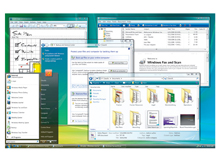The Fujitsu Plasmavision had a huge - for then - 42-inch display, measured just 60mm deep and at £11,600 cost about the same as an entry-level Volkswagen Golf. It was immediately apparent, of course, that there were some things the Fujitsu just couldn’t do.
It only had a 160-degree viewing angle, contrast and picture quality were poor, and the Plasmavision’s image resolution was a laughable 852 x 480 pixels - not that there were any high definition sources you could feed it then, of course: you had a choice then of VHS, S-VHS, DVD or laserdisc.
Frankly for the money, you could buy a top quality CRT several times over. The Plasmavision didn’t even include an analogue TV tuner.
Other problems quickly raised their heads as well: within months owners were complaining about screen burn caused by TV channel logos (a problem common that plagued all early plasmas) and the display’s limited life span - 30,000 hours to half-brightness.
Today, of course it’s a completely different story: flat panels are finally getting good enough to truly challenge CRT, only it’s LCD not plasma that has emerged as the dominant force - and to prove the point last December Fujitsu announced that it was to stop plasma TV production.
Microsoft Windows Vista

It looks nice. Can I have XP instead?
Sign up for breaking news, reviews, opinion, top tech deals, and more.
There can be few operating systems that are so widely reviled as Windows Vista. Just as Apple tried to with Copland in 1990s, so Microsoft tried to do here. It wanted a bang-up-to-date OS that could compete with the flash and dash of Mac OS X. It appears to have largely failed in that ambition.
Microsoft had hoped that Windows Vista (originally codenamed Longhorn) would go from conception in 2001 to execution within two years, but the whole project was beset by delays, largely as the result of trying to cram in features like WinFS - a new kind of data management system that enabled files to by identified by type (picture, movie, etc).
By 2004 Longhorn, and WinFS were running into trouble, leading Microsoft to abandon both in favour of a completely new version of the OS now dubbed Windows Vista, which promised increased security, desktop search and a fresh new look dubbed Aero.
Windows Vista finally made its debut in Las Vegas in January 2007, with the catchy launch slogan “The Wow Starts Now”. It quickly came back to haunt the company.
Early versions were horribly slow and buggy, and many users found that the operating system simply wouldn’t work on their PCs in the way that they had been told - chiefly because Aero was graphically intensive.
Some Microsoft executives even admitted privately that they don’t get Windows Vista to run properly on ‘Vista Capable’ PCs. “We completely botched this,” Jim Allchin, the Microsoft VP responsible for Windows Vista wrote in an email. Another said of his Windows Vista cabable PC “I now have a $2,100 email machine.”
Worse for many home users was the news that the Direct X 10 graphics engine didn’t work properly, many hardware drivers were missing and that they were constantly being nagged by the User Access Control (UAC) system which was supposed to safeguard users from malware, but just became an annoyance.
Microsoft was also heavily criticised from coming up with no less that six different versions of Windows Vista, restricting the licensing terms and including Digital Rights Management (DRM).
Despite Microsoft continuing protests that Windows Vista has become one of its successful launches ever, many users and businesses remain unconvinced, clinging onto Windows XP for as long as Microsoft will allow.
The end could come soon: CEO Steve Ballmer may drop XP support by Monday 30 June. Many users, even Bill Gates, it seems, are now hoping that Windows 7 will get Microsoft out of the mire. It’s expected to arrive in 2010.